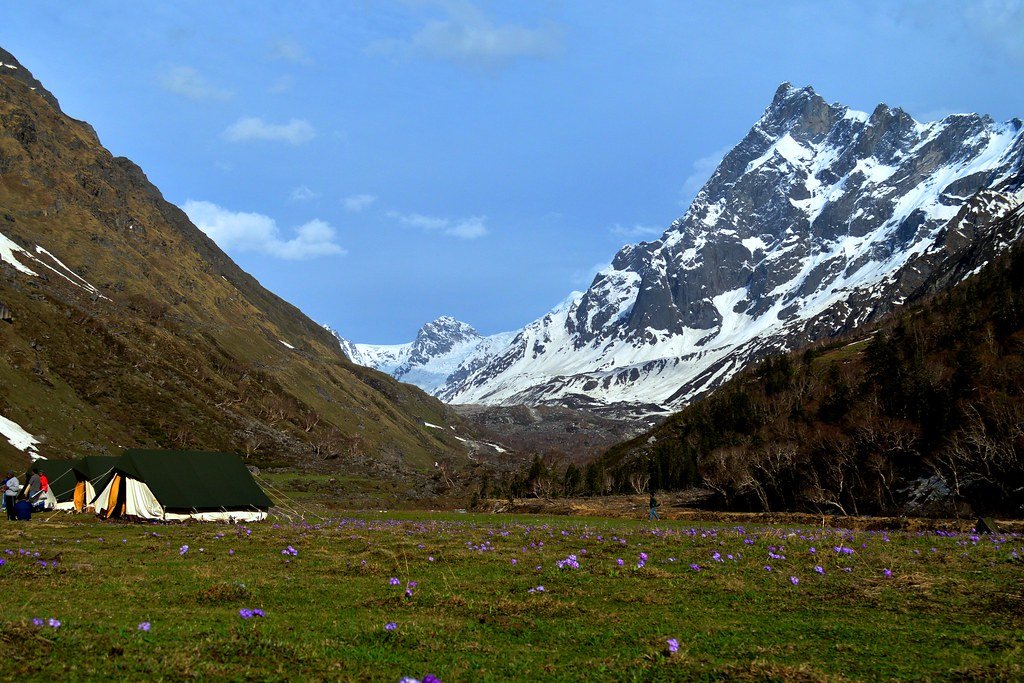Best 31 Things To Do At Lahaul And Spiti Valley
Lahaul and Spiti Valley, a district in Himachal Pradesh, India, is renowned for its rugged landscapes, high-altitude villages, ancient monasteries, and trekking trails. Geographically located in the Himalayas and the Tibetan Plateau, it is connected to Manali via the Rohtang Pass. The two valleys are divided by the Kunzum Pass, offering a stunning view of the Bara-Shigri Glacier. With an average elevation of 4,270 meters (14,010 feet), Spiti Valley ranks among the coldest places in India, receiving only 250 days of sunshine annually. As the fourth least populous district in India, Lahaul and Spiti had a population of 31,564 according to the 2011 census. The district shares close cultural ties with Tibet and is home to renowned Buddhist monasteries like Key, Tabo, Dhankar, and Trilokinath. A haven for adventure enthusiasts, Lahaul and Spiti offer numerous trekking trails, mountain passes, and wildlife attractions such as Pin Valley National Park, Chandratal Lake, and Yak Safaris. It is a destination where one can immerse in nature’s beauty, as well as the rich culture and history of the Himalayas.
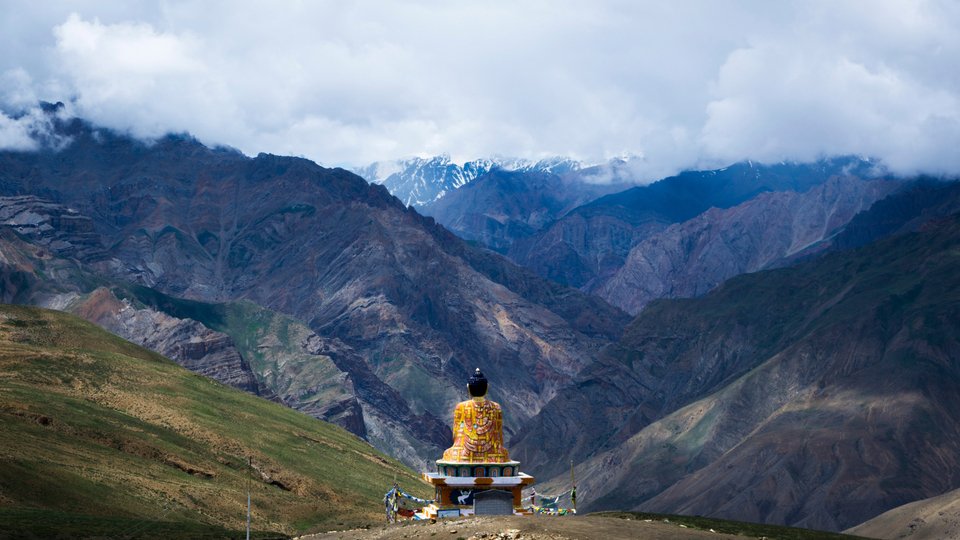
Things To Do At Lahaul & Spiti:
1. Visit Key Monastery:
Key Monastery, situated in the Spiti Valley. stands as the oldest and largest Tibetan Buddhist monastery in the region. This revered institution serves as a pivotal hub for local learning and culture. Its reputation extends beyond academia, drawing visitors with its breathtaking architecture, ancient murals, and panoramic vistas of the Spiti River and the encompassing mountains. The optimal times to visit Key Monastery are from March to June or from October to December. While there is no entry fee, donations for the monastery’s upkeep are appreciated. For those interested in staying overnight, rooms can be booked for INR 250 per night, inclusive of meals. However, it is advisable to notify the monastery well in advance to secure accommodations.

Visit time: 6:00 AM to 6:00 PM
2. Explore Chandratal Lake:
The Chandratal Lake trek in Lahaul and Spiti is a mesmerizing journey through rugged terrain that rewards adventurers with stunning vistas and a sense of tranquility. This high-altitude trek, set amidst the majestic Himalayas, offers a glimpse into the raw beauty of the region. The trek usually starts from Batal and takes about 2-3 days to reach Chandratal Lake, a crescent-shaped body of crystal-clear water that reflects the surrounding snow-capped peaks. The trail is challenging yet immensely rewarding, making it a must-visit for trekking enthusiasts looking for an unforgettable experience in the Himalayas.
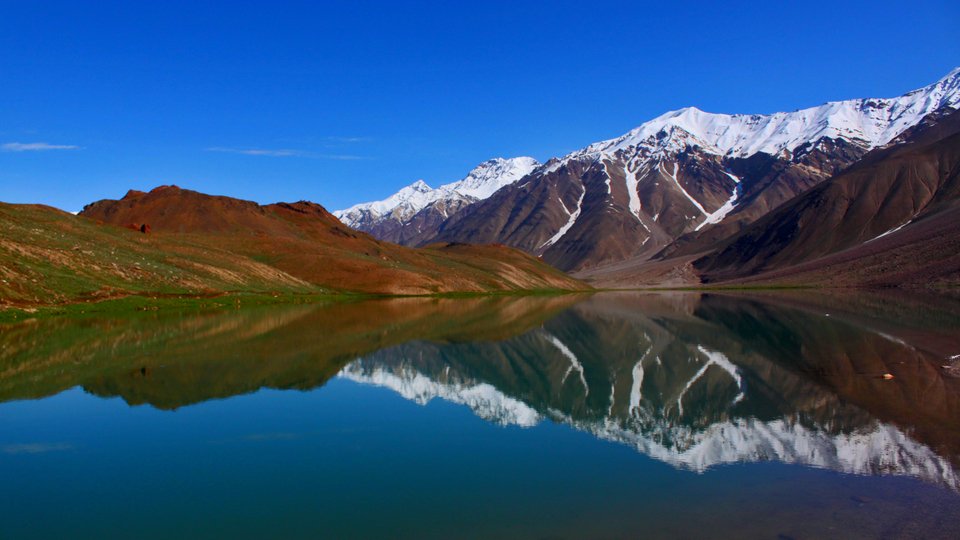
3. Drive to Kunzum Pass:
Kunzum Pass, located in the eastern Kunzum Range of the Himalayas, serves as a vital link between the Lahaul and Spiti valleys. This scenic mountain pass is traversed by travelers en route from Gramphoo in Lahaul to Kaza, the administrative center of Spiti. Offering breathtaking vistas of snow-capped peaks, arid landscapes, and fluttering Buddhist flags, Kunzum Pass is renowned as one of the country’s most picturesque and adventurous routes. The pass is also home to the revered Kunzum Mata temple, a significant stop for all travelers crossing this high-altitude pass. Locals believe that the goddess Kunzum safeguards travelers from mishaps on their journey. Typically open from June to October, depending on snow conditions, Kunzum Pass is a sought-after destination for trekkers, bikers, and nature enthusiasts seeking an unforgettable Himalayan experience.

4. Experience The Natural Beauty Suraj Tal:
Suraj Tal, a stunning lake in the Lahaul and Spiti district. sits just below the Bara-lacha-la pass. This pass is a crucial link connecting the valleys of Lahaul, Spiti, Zanskar, and Ladakh. Suraj Tal is not only a breathtaking sight but also holds the distinction of being the third-highest lake in India and the 21st-highest in the world, standing at an elevation of about 4,890 meters. The lake is fed by glaciers and snowmelt from the pass and serves as the source of the Bhaga River, a tributary of the Chenab River. Sacred to Hindus, Suraj Tal is believed to have been blessed by the Sun God, Surya, with his divine grace. During the summer months, many pilgrims visit this sacred site seeking spiritual guidance and healing.
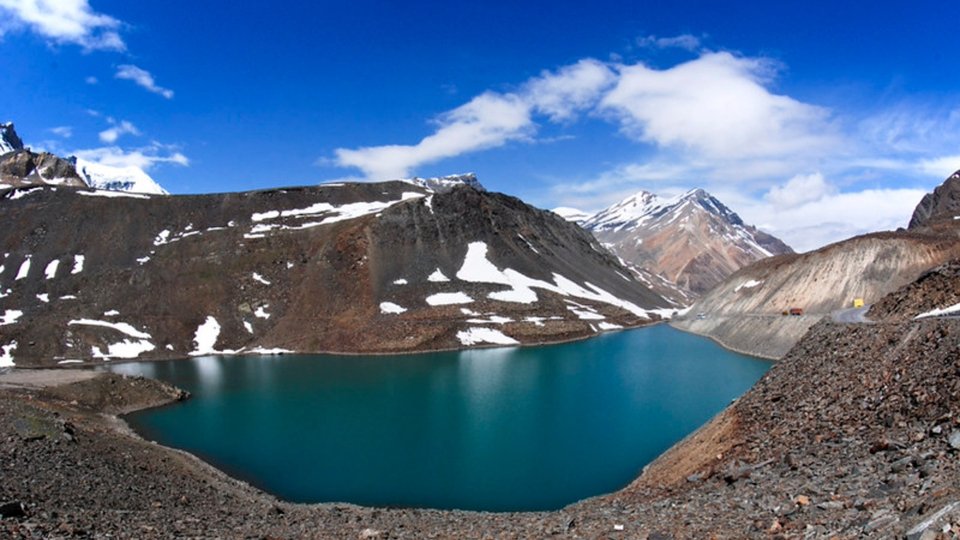
5. Take Blessings At Dhankar Monastery:
Dhankar Monastery, located at 3,894 meters in Lahaul and Spiti, is a Buddhist temple with a rich history and stunning setting overlooking the confluence of the Spiti and Pin Rivers. It is one of the world’s most endangered monuments due to erosion and neglect. Founded around the 12th century, it was once the capital of the Spiti Kingdom. The monastery, belonging to the Gelug school, features a unique statue of Vairocana and a museum showcasing ancient scriptures and murals. A new monastery nearby houses 150 monks, and a 2 km hike leads to Dhankar Lake. It is a significant cultural, historical, and spiritual site, attracting visitors seeking the beauty and serenity of the Spiti Valley.
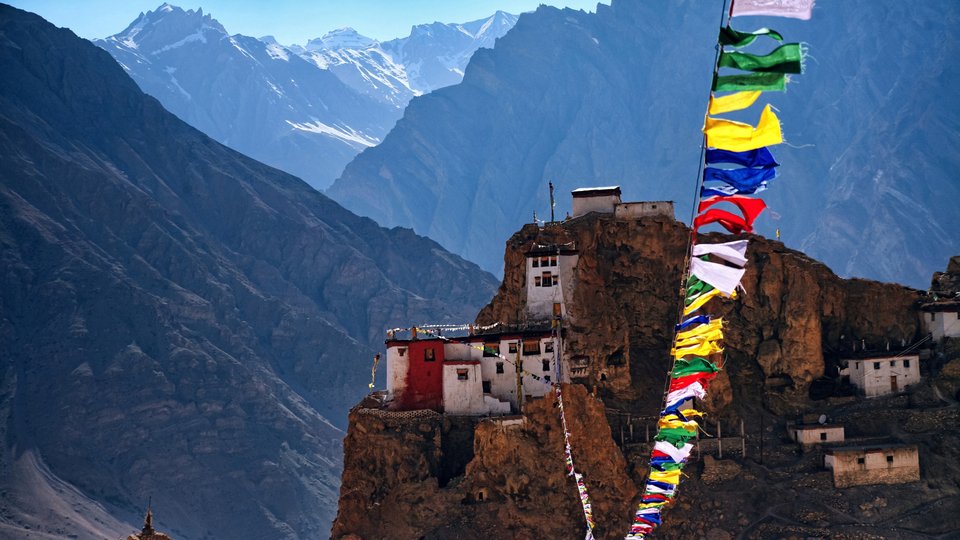
Visit Time: 6:00 AM to 6:00 PM
6. Visit Tabo Monastery:
Tabo Monastery, situated in the Spiti Valley, is renowned as one of the oldest and most well-preserved Buddhist monasteries in the Himalayan region, with origins dating back to 996 CE. Dubbed the “Ajanta of the Himalayas,” it is celebrated for its exquisite murals and paintings. Founded by the Tibetan translator Rinchen Zangpo, under the patronage of the king of Guge, Tabo Monastery comprises nine temples, four stupas, 23 chortens, and numerous cave shrines. It houses a remarkable collection of ancient scriptures, statues, and artworks. A sacred site for Tibetan Buddhists, Tabo Monastery has hosted the Dalai Lama twice for the Kalachakra ceremonies. Designated a UNESCO World Heritage Site and protected by the Archaeological Survey of India, Tabo Monastery is a compelling destination for those fascinated by Himalayan history, culture, and spirituality. A visit to Spiti Valley would be incomplete without exploring the wonders of this ancient monastery and its surroundings.
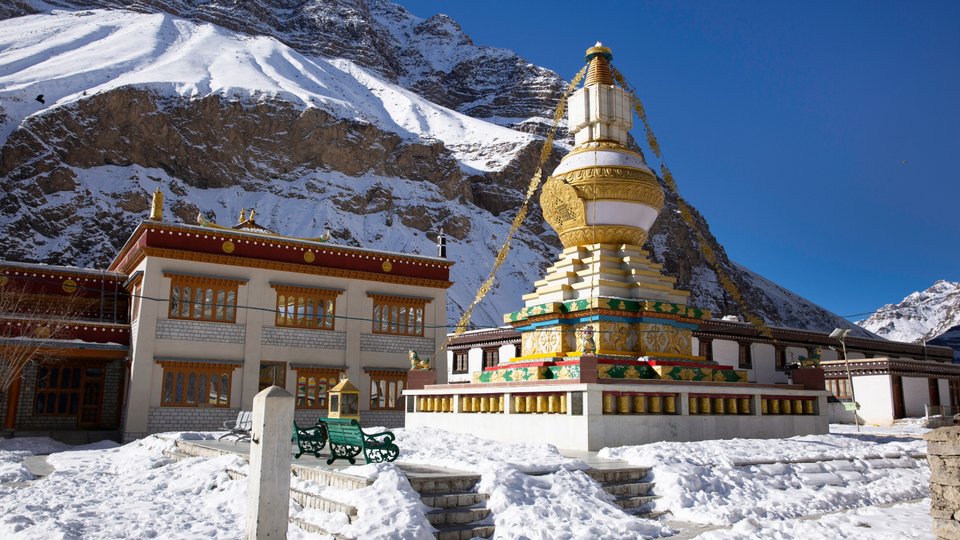
Visit Time: 6 am to 7 pm
7. Trek to the Pin Valley National Park:
Pin Valley National Park, nestled in the Spiti Valley, falls within the Lahaul and Spiti district. Established in 1987 as part of the Cold Desert Biosphere Reserve, it spans 675 square kilometers, aiming to protect the region’s unique flora, fauna, and cultural heritage. This national park is a sanctuary for over 20 animal and bird species, including the endangered snow leopard, ibex, bharal, and red fox. It also boasts a diverse array of medicinal plants, some of which are threatened yet possess significant medicinal properties. Situated in the cold desert region of the Himalayas, Pin Valley National Park endures extreme temperatures and heavy snowfall in winter. The optimal times to visit are from April to May and from November to December, when animals descend to lower altitudes. Accessible by road from Shimla or Kullu, visitors can trek from Mikkim village. The park provides amenities such as inspection paths, bunkers, transit accommodation, local guides, and Chhumurthi horses for an enriching experience.
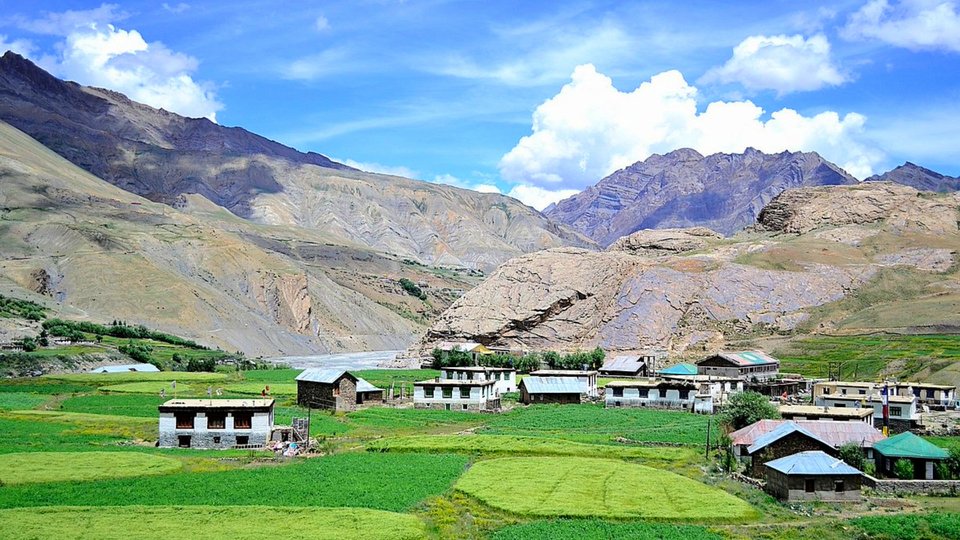
Visit Time: 6:00 AM to 6:00 PM
8. Visit Kibber Village:
Kibber Village, located in the Spiti Valley, is renowned as one of the highest inhabited villages in the world, sitting at an elevation of around 4,270 meters (14,200 feet). This picturesque village is surrounded by breathtaking Himalayan landscapes, offering stunning views of snow–capped peaks and rugged terrain. Kibber is known for its traditional stone and mud-brick houses, along with its ancient monastery that adds to the village’s charm. The village is also a gateway to the stunning Kibber Wildlife Sanctuary, home to diverse flora and fauna, including the elusive snow leopard. Trekking enthusiasts often use Kibber as a base to explore the nearby high-altitude regions, making it a popular destination for adventure seekers and nature lovers alike.
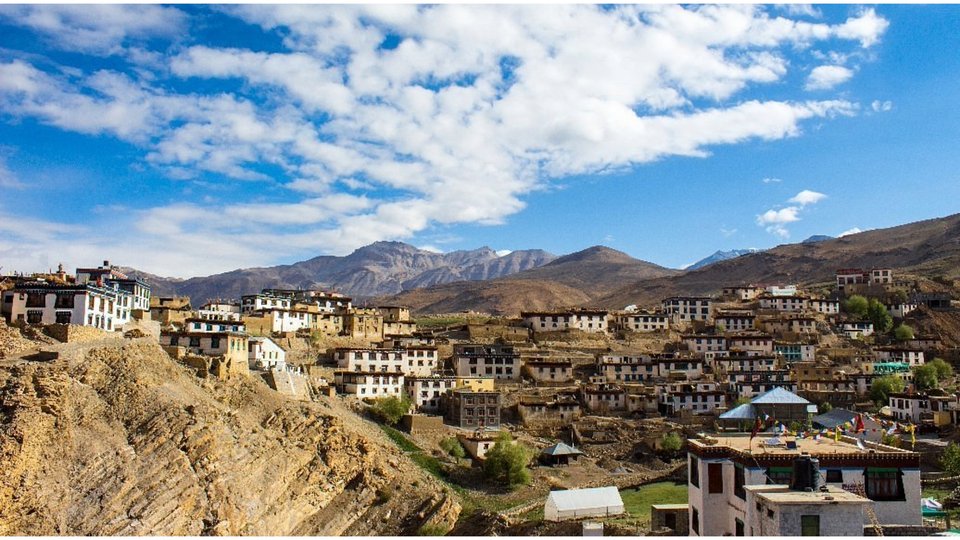
9. Explore The Devine At Kaza Village:
Kaza, the sub-divisional headquarters of the Lahaul and Spiti district, is a quaint town nestled amidst the mighty Himalayas. Situated at an altitude of around 3,650 meters (11,980 feet), Kaza is renowned for its stunning landscapes, rugged mountains, and serene Buddhist monasteries. The town serves as a gateway to the pristine Spiti Valley and is a haven for adventure enthusiasts, offering opportunities for trekking, camping, and exploring the unique culture and traditions of the region. Kaza is also known for its traditional mud-brick houses, bustling markets, and warm hospitality, making it a must-visit destination for those seeking an offbeat Himalayan experience.
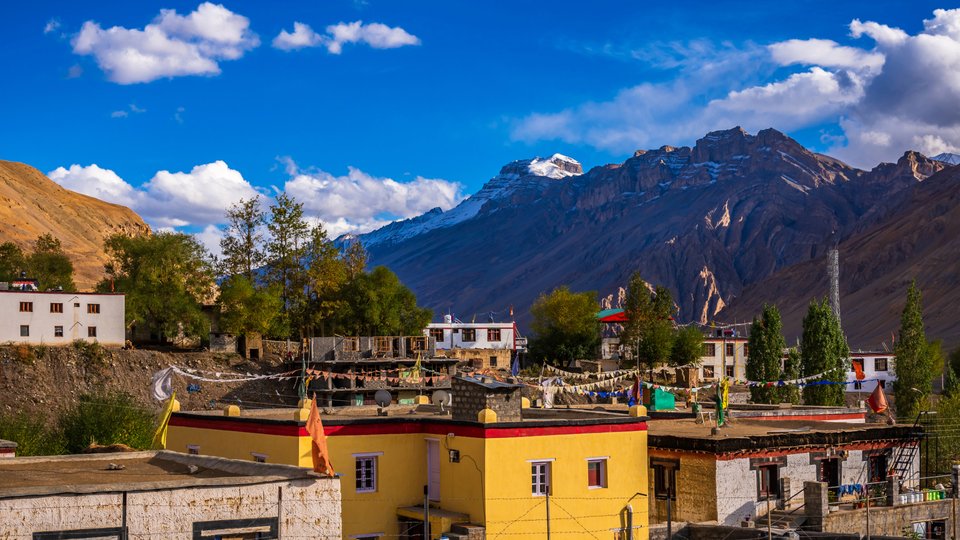
10. Trek to Dhankar Lake:
Dhankar Lake, situated in the scenic Spiti Valley, is a stunning high-altitude lake perched above the Dhankar monastery. This ancient fort monastery was once the capital of the Spiti Valley Kingdom. The lake, located approximately 2 km from the monastery, is accessible via a trek and is surrounded by picturesque pink-brown hills, showcasing a mesmerizing blue-green hue. Considered sacred by locals, the lake provides a serene and idyllic camping spot. For those interested in visiting Dhankar Lake, the optimal time is from June to September, when the weather is pleasant, and the roads are accessible. Known also as Sar Kund Lake, meaning “lake of the golden fish,” legend has it that a golden fish resides in the lake, granting wishes to those who capture it. Dhankar Lake is just one of the many breathtaking lakes in the Lahaul-Spiti region, such as Chandra Tal and Suraj Tal, offering spectacular views and adventure opportunities. Whether by bike, car, or trekking, these lakes provide unforgettable experiences amidst the majestic Himalayan landscapes.

11. Explore Mud Houses Of Tabo Village:
Tabo, a charming town in the Lahaul and Spiti district, is renowned for its ancient Buddhist monastery, believed to be over a thousand years old. This monastery is adorned with intricate wall paintings and mud statues that depict Tibetan culture and art. Tabo is a haven for adventure enthusiasts, offering breathtaking views of snow-capped mountains and the serene Spiti River. To reach Tabo, you can travel by road from Manali or Rekong Peo. The nearest airport is located in Kullu, approximately 250 km (155 mi) away. Alternatively, you can take a bus or taxi from Shimla, which is about 365 km (227 mi) away. Tabo experiences a cold desert climate, characterized by minimal rainfall and extreme temperatures. The ideal time to visit is from May to October when the weather is pleasant, and the roads are clear. During winter, temperatures can plummet below -40°C (-40°F), and roads may be impassable due to snow.
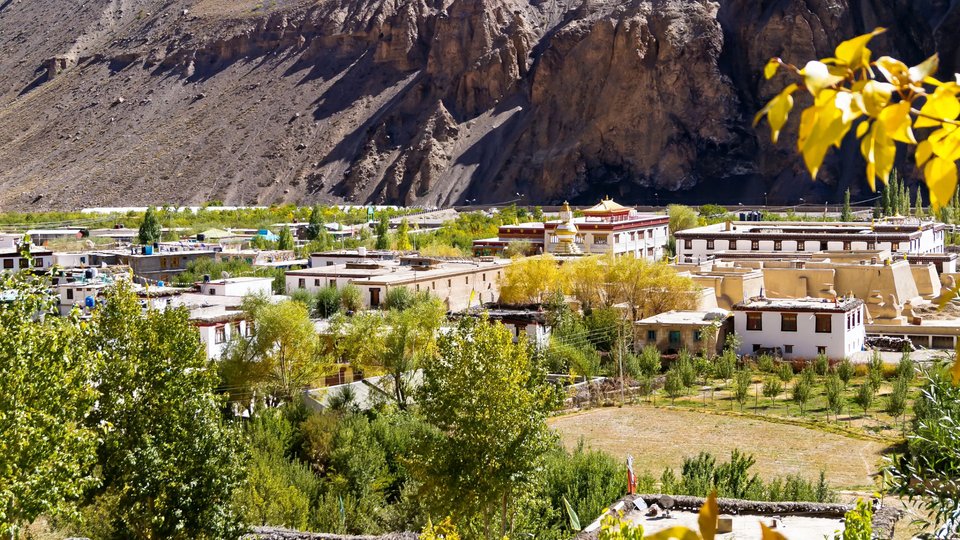
12. Feel The Spirituality Of Giu Mummy:
The Giu Mummy, a 500-year-old Buddhist monk mummy, was unearthed in a secluded village in the Spiti Valley. This remarkably well-preserved mummy includes intact hair, nails, teeth, and skin. Legend suggests the monk achieved self-mummification through meditation and natural processes. The mummy is housed in a glass case within a shrine near Giu village, drawing numerous curious visitors keen to learn about its intriguing history and spiritual significance.
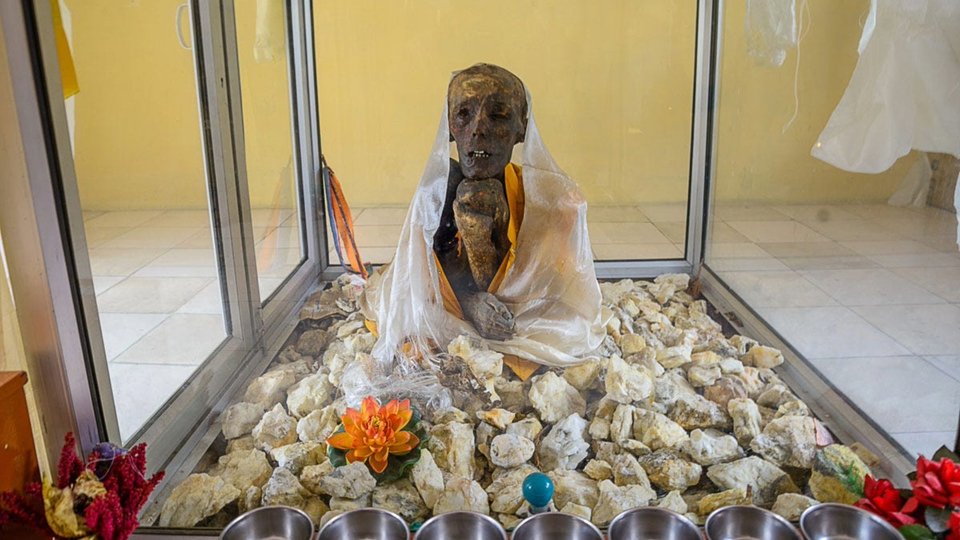
13. Experience The History At Tabo Caves:
Tabo Caves, located near the Tabo village in the Lahaul and Spiti district, are a series of ancient caves that hold immense historical and archaeological significance. These caves are believed to have been used by monks for meditation and living quarters, dating back to over a thousand years. The caves are carved into the rocky cliffs, showcasing intricate designs and paintings that depict the rich Buddhist culture and art of the region. Tabo Caves offer a fascinating glimpse into the lives of ancient monks and are a testament to the enduring spiritual legacy of the area.
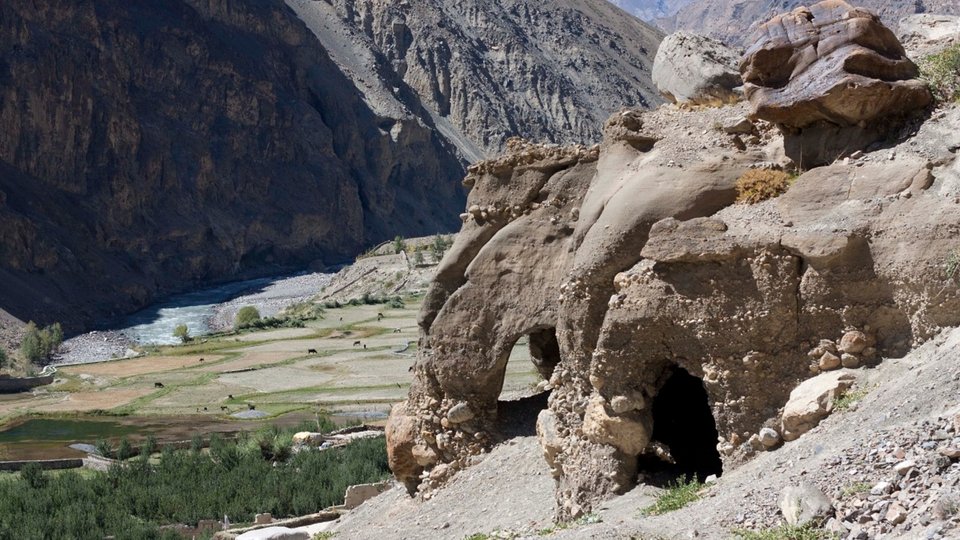
14. Sail The Spiti River:
The Spiti River, a tributary of the Sutlej River, spans 225 kilometers and originates from the Kunzum Range of the Himalayas. Meandering through the picturesque valleys of the Lahaul and Spiti district, it serves as a lifeline for the local inhabitants and sustains numerous ancient monasteries along its path. Aptly named “the middle land,” the Spiti River lies between Tibet and India, embodying a unique cultural and geographical significance. Fed by the melted glaciers of the Himalayan ranges, the river flows through a cold desert environment, adding to its mystique and charm.
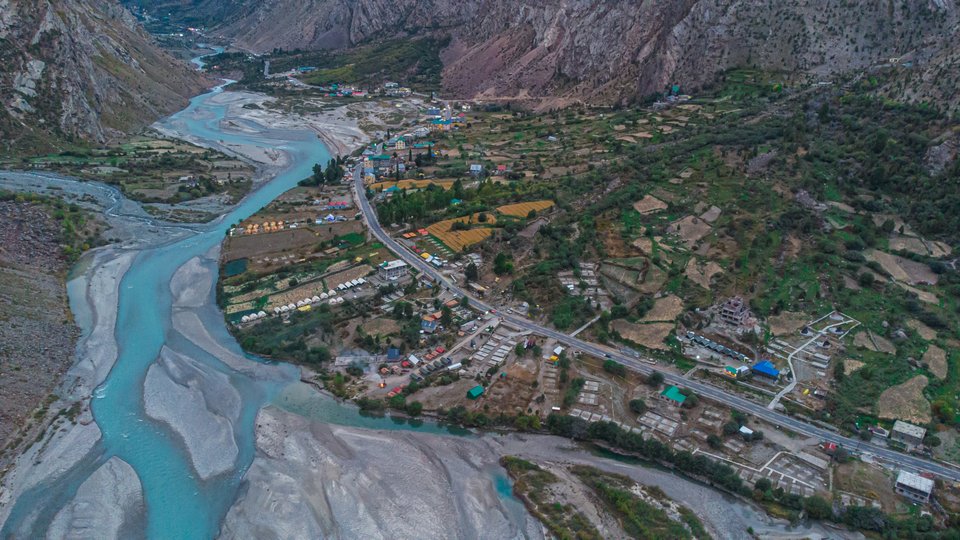
15. Experience The Nature And Devine At Gandhola Monastery:
Gandhola Monastery, also known as Guru Ghantal Monastery, is a revered Buddhist monastery located in the Lahaul and Spiti district. Founded in the 8th century by Padmasambhava, it stands as one of the region’s oldest monastic establishments. Perched atop a hill overlooking the confluence of the Chandra and Bhaga rivers, which merge to form the Chenab river, the monastery offers a breathtaking view of the surrounding landscape. The monastery houses a collection of wooden idols, including those of Buddha, Guru Padmasambhava, and various deities, alongside intricate paintings, murals, and sculptures. Adding to its historical allure, the monastery features a seven-storey fort constructed by Raja Man Singh of Kullu. Each year, the monastery hosts the Ghantal festival, a vibrant celebration where lamas perform masked dances, showcasing the rich cultural heritage of the region. Gandhola Monastery stands as a testament to the ancient Buddhist traditions and architectural splendor of the Lahaul and Spiti valley.
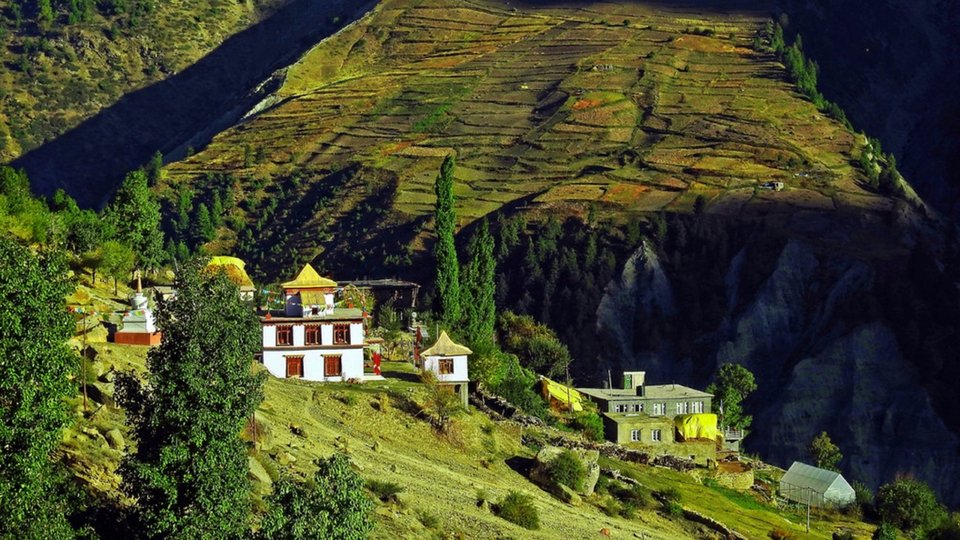
Visit Time: 6 am to 6 pm
16. Magnet For Tourists – Komik Village:
Komik, a charming village in Lahaul and Spiti district, stands out as Asia’s highest village, perched at an astounding altitude of 18,000 feet above sea level. This picturesque village is renowned for its Buddhist monastery, also the world’s highest motorable monastery. Surrounded by snow-capped peaks and breathtaking valleys, Komik is a magnet for tourists seeking natural beauty and cultural heritage experiences. The village is also a treasure trove of fossil life and a haven for trekking enthusiasts. The optimal time to visit Komik is from May to October when the roads are accessible, and the weather is pleasant, offering an unforgettable Himalayan adventure.
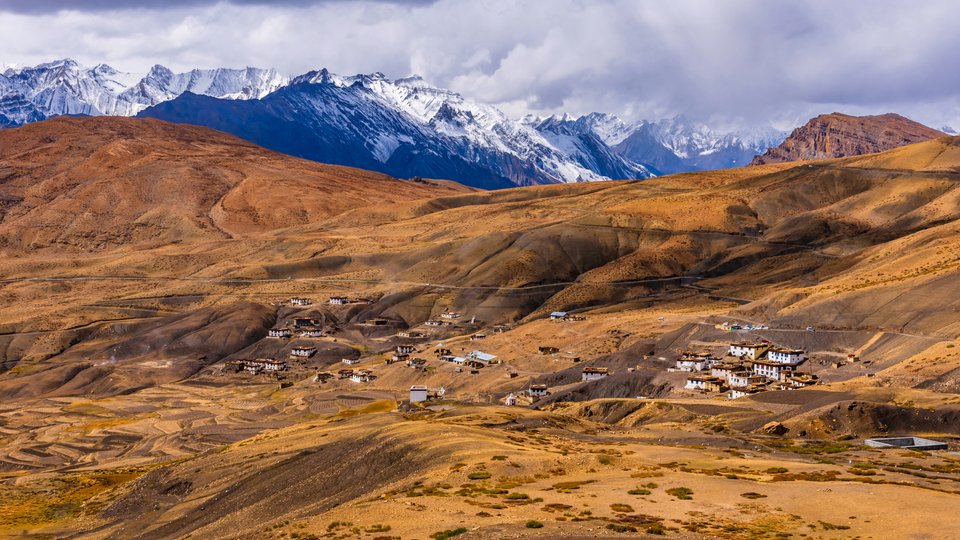
17. Trek To Sopona Lake:
Sopona Lake, also known as Sapona Lake or Mane Lake, is a seasonal lake fed by glacial melts from the Manirang mountain range, among the highest in Himachal Pradesh. Situated near Mane village, between Tabo and Dhankar in the stunning Spiti Valley, the lake is accessible only via a 2-3 hour trek from upper Mane village. Offering breathtaking vistas of the Spiti Valley and the snow-capped peaks of the Manirang range, this hidden gem is best visited from May to September when it is brimming with water. Sopona Lake is a lesser-known treasure of Spiti Valley, waiting to be explored by adventurous souls seeking tranquility amidst nature’s splendor.
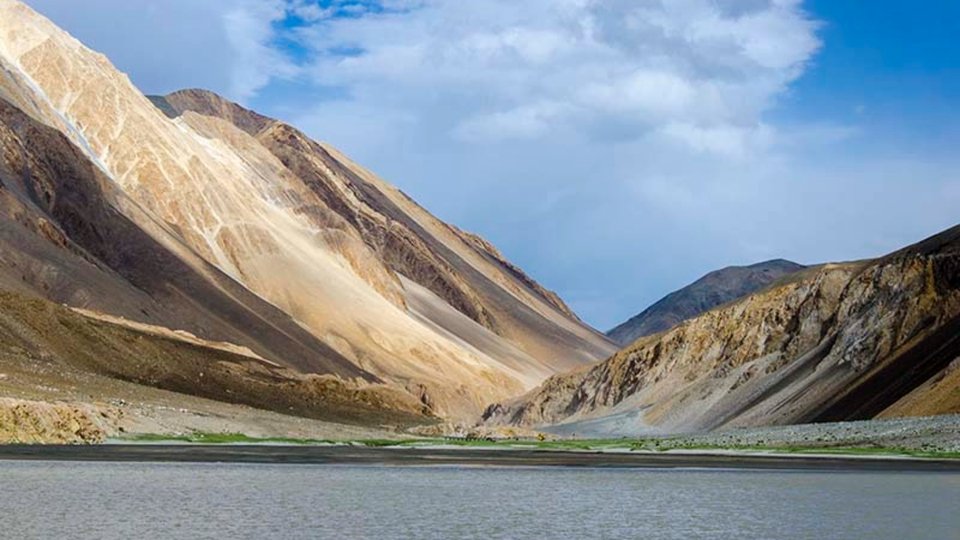
18. Admire The Purity Of Sakya Tangyud Monastery:
Sakya Tangyud Monastery, a Tibetan Buddhist monastery, stands proudly in the village of Komic, nestled in Spiti Valley, India. This monastery claims one of India’s highest altitudes, perched at 4,520 meters (14,830 feet), and is affiliated with the Sakya sect of Tibetan Buddhism. Constructed resembling a fortified castle on the precipice of a deep canyon, Sakya Tangyud Monastery boasts massive slanted mud walls and battlements adorned with vertical red ochre and white stripes. Inside, the monastery treasures a wealth of ancient murals, thangkas, statues, and scriptures. Though its origins are believed to be ancient, Sakya Tangyud Monastery was likely built in the early 14th century, during the rise of the Sakyapas under Mongol patronage. The name “Tangyud” may allude to the Sakya revision of the Tang-rGyud, or the 87 volumes of Tantra treatises that form part of the Tengyur. Patronized by Spiti’s local chieftains, the monastery provides a special cell for their visits. Despite enduring damage from a 1972 earthquake and being the target of thefts by individuals from Kashmir and other regions, Sakya Tangyud Monastery stands as a testament to the region’s rich cultural and spiritual heritage.
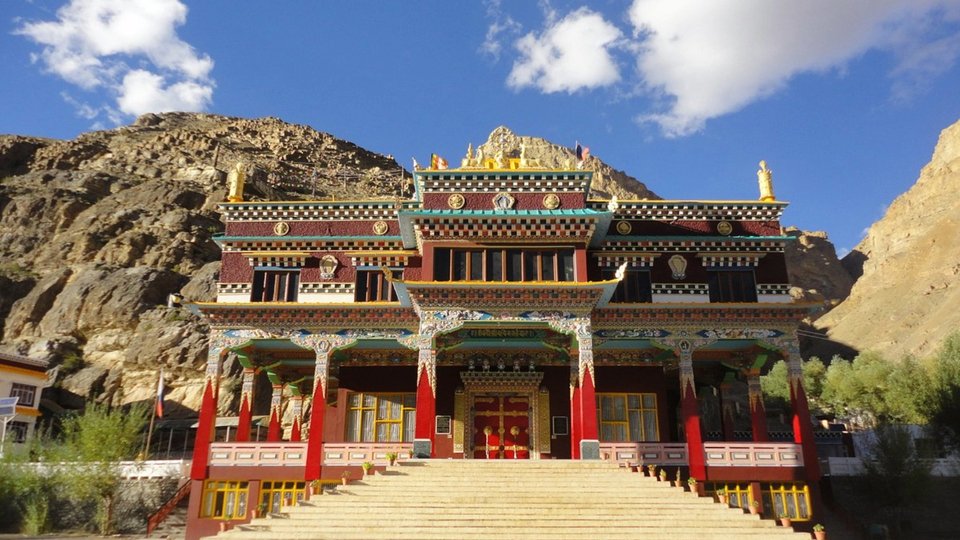
Visit Time: 6 am to 6 pm
19. Experience Tibetan Buddhist Art Of Kungri Monastery:
Kungri Monastery, located in the Pin Valley of Lahul and Spiti, is a revered Buddhist monastery belonging to the Nyingma sect of Tibetan Buddhism. As the second oldest monastery in Spiti valley and the sole practitioner of Nyingmapa Buddhism in the region, it holds significant historical and religious importance. The monastery’s architecture comprises three detached rectangular blocks facing east, adorned with exquisite murals depicting deities of the Vajrayana pantheon. Annually, in July, Kungri Monastery hosts traditional dances like the ‘Devil Dance‘ and the ‘Sword Dance’. It serves as a magnet for Buddhist scholars, pilgrims, and tourists seeking to immerse themselves in the ancient Tibetan Buddhist art, culture, and tradition.
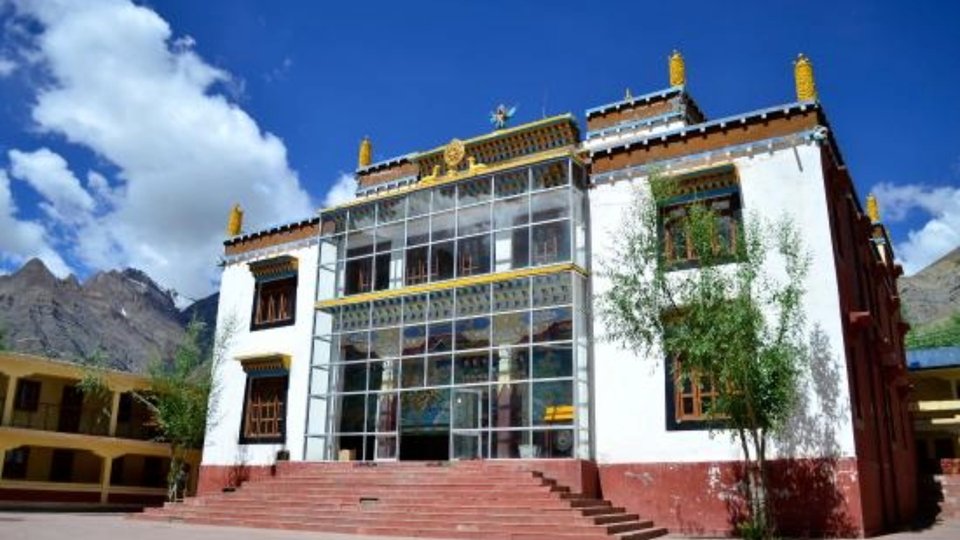
20. Narrate The Vibrant Culture Of Lhlung Monastery:
Lhalun Monastery, one of the ancient and exquisite Buddhist monasteries in Spiti Valley, dates back to the 10th century CE, founded by the renowned Tibetan translator Rinchen Zangpo. Also known as the Sarkhang or Golden Temple, this monastery is adorned with sacred art, murals, and scriptures that narrate the vibrant culture and history of Spiti. Situated in the village of Lhalun, meaning ‘land of the gods’, the monastery offers breathtaking vistas of the Himalayas, enhancing its spiritual allure.
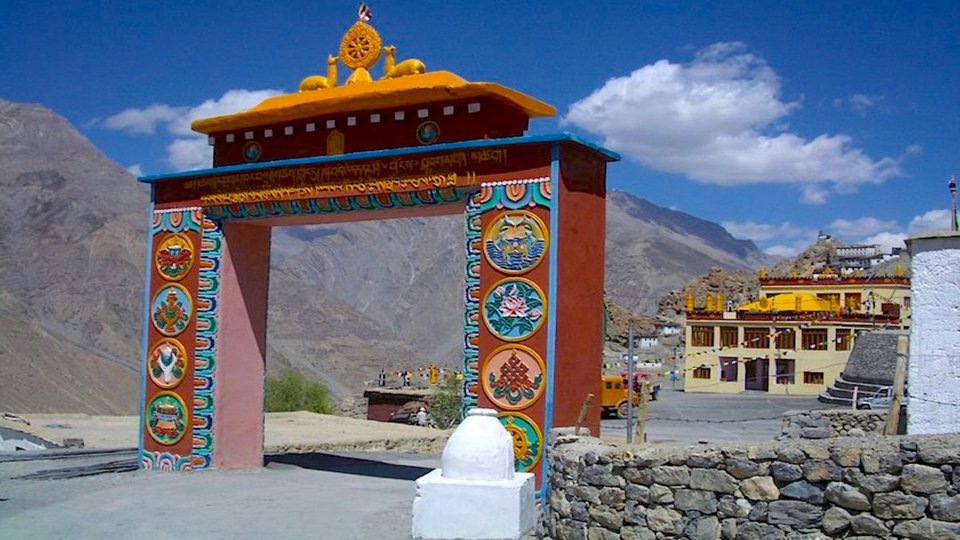
Visit Time: 6 am to 6 pm,
21. Feel Stunning Views Of Langza Village:
Langza Village, situated in Spiti Valley, is known for its natural beauty and cultural heritage. At an altitude of 4,400 meters, has a population of around 150 people. it offers stunning views of the Himalayas. The village is famous for its fossil deposits and is called “The Fossil Village.” Langza also boasts the ancient Lang Temple, which houses a large Buddha statue and provides a peaceful environment for meditation. The village offers a glimpse into traditional life, with agriculture and animal husbandry being the main activities. It’s an ideal destination for those seeking tranquility amidst the Himalayas and a taste of local Spitian culture.
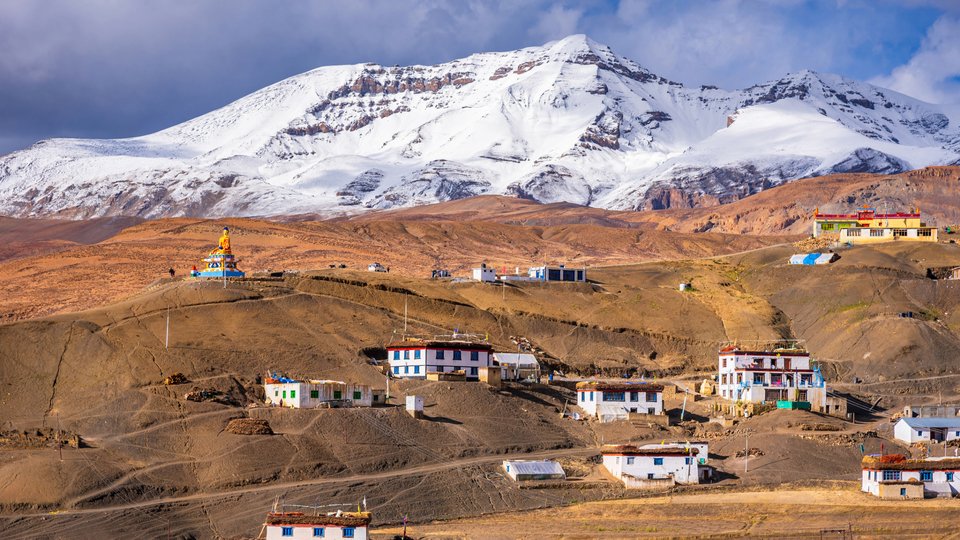
22. Hike To Snow-Capped Peaks Of Tashigang Village:
Tashigang Village, located in the Spiti Valley, is a remote and picturesque settlement surrounded by towering mountains and barren landscapes. Situated at an altitude of approximately 4,100 meters (13,450 feet), Tashigang offers breathtaking views of the rugged terrain and the snow-capped peaks of the Himalayas. The village is known for its traditional mud-brick houses and ancient Buddhist monastery, which add to its charm and cultural significance. The monastery, perched on a hill overlooking the village, provides a serene setting for meditation and offers a glimpse into the rich Buddhist heritage of the region. Tashigang is a peaceful and tranquil destination, ideal for those looking to experience the beauty of the Himalayas and explore the unique culture of the Spiti Valley. The village is also a starting point for treks and hikes into the surrounding mountains, making it a popular destination for adventure enthusiasts and nature lovers alike.

23. Explore The Heights Of Hikkim:
Hikkim, a quaint village located in the Lahaul and Spiti district, is renowned as one of the highest year-round inhabited villages in the world, situated at an altitude of approximately 4,400 meters (14,567 feet). This picturesque village is known for its traditional mud-brick houses and stunning views of the surrounding snow-capped mountains. Hikkim is also famous for its ancient post office, which is believed to be the world’s highest post office, providing postal services to the local residents and serving as a unique tourist attraction. A visit to Hikkim offers a glimpse into the traditional life of the Spiti Valley and an opportunity to marvel at its breathtaking natural beauty.

24. Seek The Pristine Beauty Of Baralacha Pass:
Baralacha Pass, situated in Himachal Pradesh, India, is a high mountain pass in the Zanskar range of the Himalayas. At an altitude of about 4,890 meters (16,040 feet), it connects the Lahaul and Spiti district with Ladakh. The pass offers breathtaking views of snow-capped peaks, glaciers, and lush meadows. It has historical significance as an ancient trade route and is popular among adventure enthusiasts, especially trekkers and bikers. Suraj Tal Lake, one of the highest lakes in India, is located nearby. Despite its challenging terrain and harsh weather, Baralacha Pass is a captivating destination for those seeking the pristine beauty of the Himalayas.
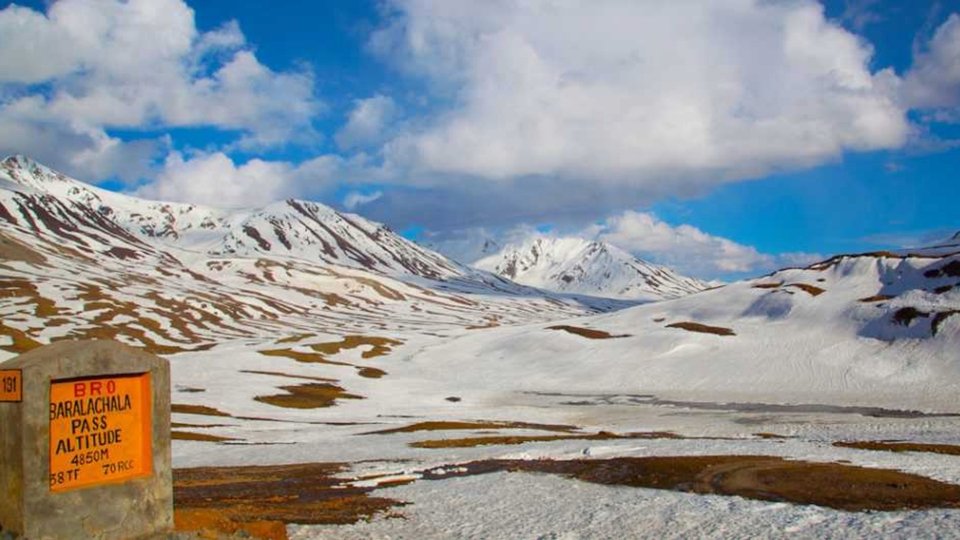
25. Panoramic Views Of Dhankar Gompa:
Dhankar Gompa, located in the Spiti Valley, is a historic Buddhist monastery that dates back to the 12th century. It is located at an elevation of 3,894 metres (12,774 feet) in the Spiti Valley, Perched on a cliff above the confluence of the Spiti and Pin Rivers, it offers stunning panoramic views of the surrounding valley and mountains. The monastery, belonging to the Gelug school of Tibetan Buddhism, houses a statue of Vairocana, the Buddha of light, and features ancient scriptures, murals, and sculptures. Dhankar Gompa is not only a religious center but also a place of great historical and cultural significance, attracting visitors interested in Tibetan Buddhist art, culture, and spirituality.
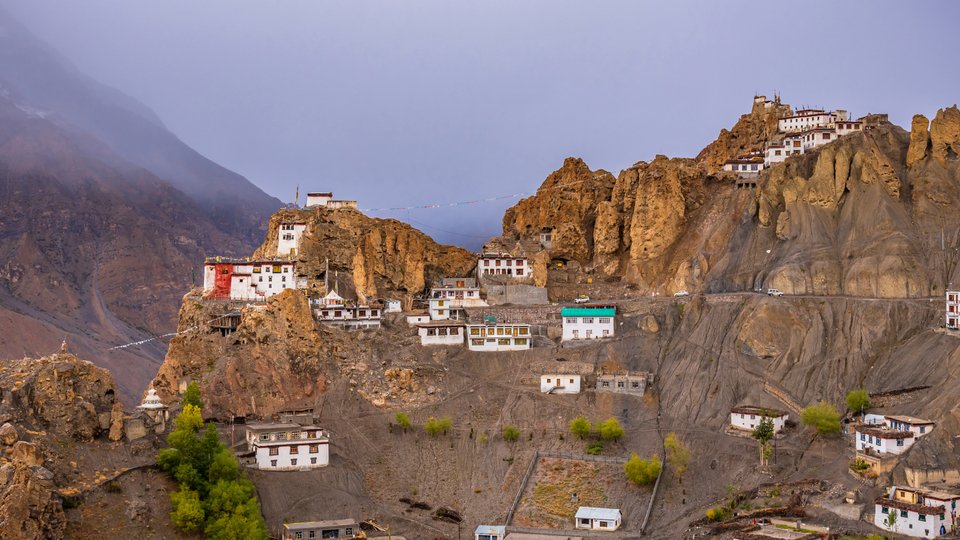
26. Feel The Devine At Trilokinath Temple:
Trilokinath Temple, situated in Lahaul and Spiti district, is a revered shrine worshipped by Hindus and Buddhists alike. Devotees regard the deity as either Lord Shiva or Arya Avalokiteshwar. Also known as Tunda Vihar or Sri Trilokinathji Temple, it lies approximately 9 km from Udaipur village and 146 km from Manali. The temple’s origins trace back to the 10th century, believed to be constructed by the ancestors of the Rana Thakurs, in collaboration with King Shell Varman of Chamba. Its white-painted structure is adorned with vibrant Tibetan prayer flags and a brass bell. Annually, the temple hosts the Pori Mela festival, drawing pilgrims from afar.
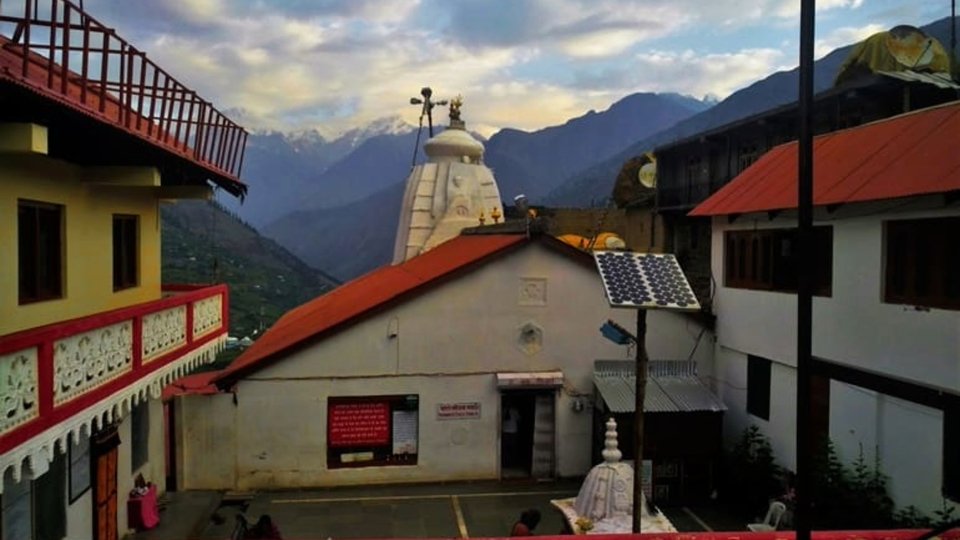
Visit Time: 6:00 am 8:00 pm
27. Trekking in Spiti Valley:
Trekking in Spiti Valley, offers an adventurous exploration of its rugged terrain, high-altitude desert, and ancient monasteries. Popular treks like Pin Parvati Pass, Hampta Pass, Chandratal Lake, and Parang La cater to various skill levels. Summer (June to September) is the best time to trek, but weather can be unpredictable, so check local forecasts. Some treks require permits, and accommodation ranges from camping to basic guesthouses. Trekking here provides cultural immersion and interaction with local communities. It’s crucial to be well–prepared, physically fit, and equipped, and consider hiring a guide for a safe and enjoyable experience.

28. Enjoy Blue Pines At Shashur Monastery:
Shashur Monastery, a Buddhist monastery of the Drugpa sect, is situated in Lahaul and Spiti, about 137 kilometers from Manali. Its name, “Sha-shur,” translates to “blue pines” in the local dialect, referencing the blue pine patches surrounding the monastery. Established in the 17th century by Lama Deva Gyatsho, a Bhutanese king’s missionary, the monastery is renowned for its annual Chham festival, featuring monks performing ritual dances in vibrant masks and costumes. The monastery also houses a collection of ancient paintings, scriptures, and statues depicting various Buddhist deities, showcasing the diverse traditions of Tibetan Buddhism.
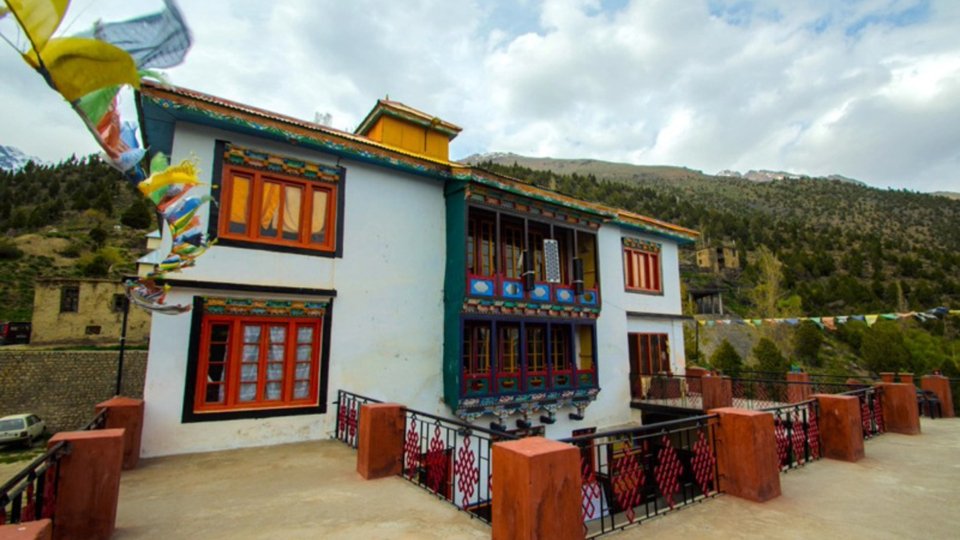
Visit Time: 6 am to 6 pm
29. Visit Tibet’s Kham Region – Tayul Monastery:
Tayul Monastery, a Buddhist monastery in Lahaul Valley, is affiliated with the Drugpa sect of Tibetan Buddhism. Renowned for its spiritual significance, ancient murals, and a large statue of Padmasambhava (Guru Rinpoche), it was established in the 17th century by Lama Serzang Rinchen of Tibet’s Kham region. The name “Tayul” translates to “chosen place” in Tibetan, reflecting its esteemed status. The monastery boasts a library housing 101 Buddhist scriptures, the Kangyur, and Thangkas depicting Buddha’s life. Accessible by a steep footpath from Satingri village, about 6 km from Keylong, Tayul Monastery offers scenic views of Bhaga Valley and Drilburi Peak. Visiting between June and November is ideal, as the weather is pleasant and roads are navigable.
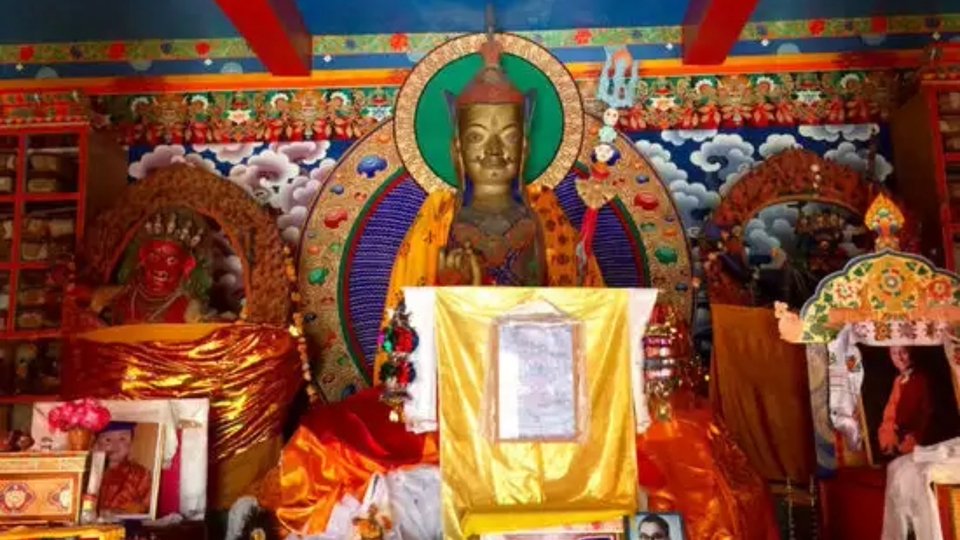
Visit Time: 6 am to 6 pm
30. Shop At Keylong Market:
Keylong Market is a bustling weekly market held every Monday at the Polo Ground in Lahaul and Spiti district, This vibrant market draws traders, tourists, and locals from across the region, offering a wide array of goods including woolen clothes, local handicrafts, dry fruits, spices, fresh produce, ayurvedic medicines, dairy products, ethnic costumes, pickles, and sakti tassels. Visitors can also indulge in traditional foods and find garments and daily essentials, making it an excellent place to immerse in the lively culture and lifestyle of Lahaul and Spiti Valley.
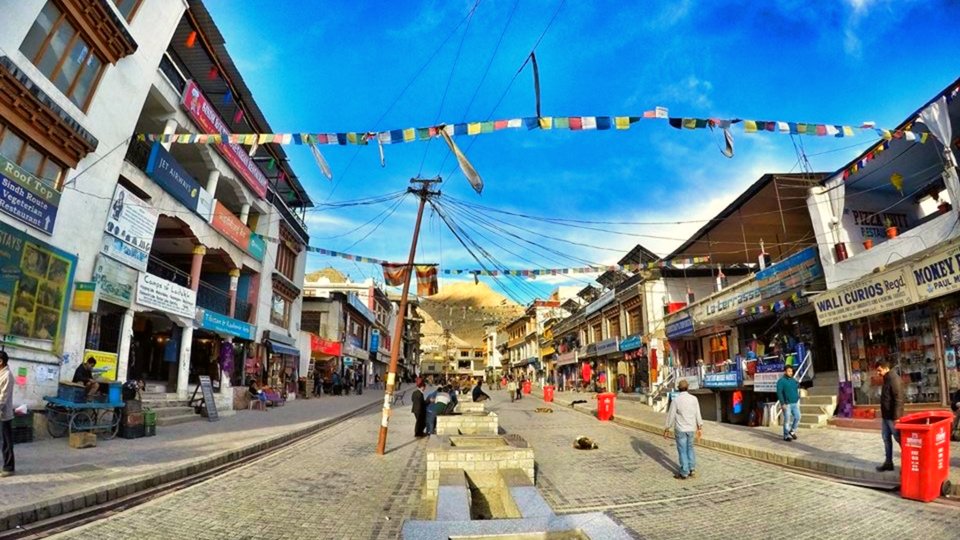
31. Be The Witness Of Drukpa Lineage – Kardang Monastery:
Kardang Monastery, a renowned Drukpa Lineage monastery in Lahaul valley, was established in the 12th century by Lama Norbu Dorje, a disciple of Tibetan Buddhist master Naropa. This white monastery, adorned with colorful prayer flags, sits on a ridge below Rangcha peak, overlooking Keylong town. It houses a substantial library containing Buddhist scriptures, ancient artifacts, and religious relics. Additionally, Kardang Monastery acts as a focal point for religious ceremonies, teachings, and social gatherings within the local community.
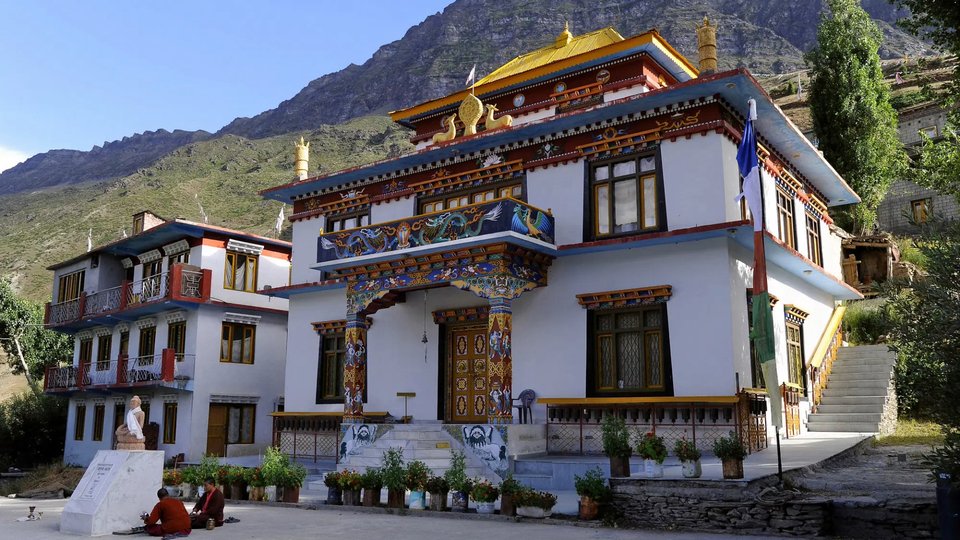
Visit Time: 6 am to 6 pm
32. Advent The Ghepan Lake Trek:
The Ghepan Lake Trek in Lahaul region is a stunning yet challenging adventure. This trek leads to a breathtaking blue glacial lake nestled at an altitude of 4146 meters, surrounded by majestic snow-capped mountains and vibrant flowers. Starting from Sissu village, approximately 40 kilometers from Manali, the trail winds through picturesque meadows, forests, and villages. The best time to embark on this trek is from May to October, offering pleasant weather and accessible lake conditions. Rated as moderate to strenuous, the trek demands good physical fitness and acclimatization. Spanning about 28 kilometers, the trek typically takes 5 days to complete.

How To Reach Delhi To Lahaul and Spiti:
There is no direct train route from Delhi to Lahaul and Spiti as Lahaul and Spiti does not have a railway station. However, you can take a train from Delhi to a nearby railway station such as Chandigarh or Pathankot, and then continue your journey to Lahaul and Spiti by road. From Chandigarh or Pathankot, you can either hire a taxi or take a bus to Manali, and then proceed to Lahaul and Spiti as mentioned earlier. Another option is to take a train to Shimla, which is connected to the Kalka-Shimla Railway, a UNESCO World Heritage Site. From Shimla, you can travel to Manali by road and then to Lahaul and Spiti.
- Delhi to Manali (By Road): The most common route is to first travel from Delhi to Manali, which is approximately 550 kilometers and takes about 12-14 hours by road. You can drive yourself, hire a private taxi, or take a bus from Delhi to Manali.
- Book A Cab: you can book a cab from our website along with a customized itinerary, or can hire just a cab for your next trip. So just do hurry. Call Us On: +911223577273
- Manali to Keylong (By Road): From Manali, you’ll need to travel to Keylong, which is the administrative headquarters of Lahaul and Spiti district. This journey is about 115 kilometers and takes around 4-5 hours by road. You can hire a taxi or take a local bus from Manali to Keylong.
- Keylong to Lahaul and Spiti Valley (By Road): Once in Keylong, you can explore different parts of Lahaul and Spiti Valley by road. The valley is well-connected by a network of roads, but many of them are narrow and winding, so travel times can vary.
- Delhi to Chandigarh to Kullu Manali Airport (By Air): An alternative option is to fly from Delhi to Kullu Manali Airport (Bhuntar Airport) near Kullu. From there, you can take a taxi or bus to Manali and then proceed to Lahaul and Spiti as mentioned above.
Nearby Places To Visit Lahaul and Spiti:
| City | Distance from Kaza | Places to visit |
|---|---|---|
| Manali | 202 km | Hadimba Temple, Solang Valley, Rohtang Pass, Old Manali |
| Shimla | 421 km | The Ridge, Mall Road, Jakhoo Temple, Kufri |
| Dharamshala | 403 km | Dalai Lama Temple, Mcleodganj, Triund, Bhagsu Waterfall |
| Chandigarh | 522 km | Rock Garden, Sukhna Lake, Rose Garden, Sector 17 Market |
| Amritsar | 560 km | Golden Temple, Jallianwala Bagh, Wagah Border, Partition Museum |
Best Time To Visit Lahaul And Spiti:
The best time to visit Lahaul and Spiti depends on your preferences and activities. Here are some general guidelines:
- Summer (May to June): For pleasant weather, clear skies, and fewer crowds, visit during the summer months. The temperature ranges from 8°C to 15°C, and the roads are open for exploration. This is the ideal time for activities like trekking, camping, and biking.
- Winter (December to February): Experience winter sports and snowy landscapes during the winter months. The temperature drops below zero, offering opportunities for skiing, snowboarding, and ice skating. Be prepared for road closures and limited facilities.
- Monsoon (July to September): Witness the vibrant colors of nature during the monsoon months. The moderate temperatures bring out the beauty of flowers, grass, and crops. However, be cautious of landslides, roadblocks, and heavy rainfall.
Frequently Asked Questions
What is Lahaul Spiti famous for?
Lahaul and Spiti are famous for their rugged landscapes, high-altitude deserts, ancient monasteries, and vibrant Tibetan Buddhist culture.
Which is the coldest place in Lahaul-Spiti?
The village of Kaza in Spiti Valley is often considered the coldest place in Lahaul-Spiti, experiencing extremely low temperatures, especially during the winter months.
Can we see snow in Spiti Valley?
Yes, snow can be seen in Spiti Valley, especially during the winter months from December to February when the region is covered in a blanket of snow.
How many days are enough for Spiti?
A minimum of 7-10 days is recommended to explore Spiti Valley thoroughly, including travel time from Manali or Shimla, and to experience its key attractions and activities.



